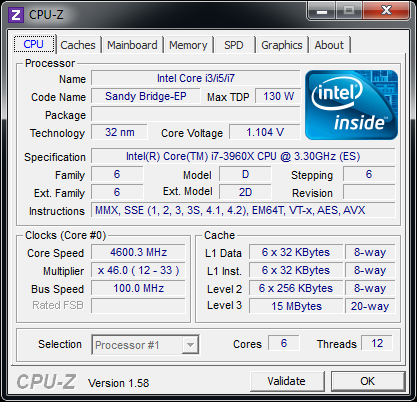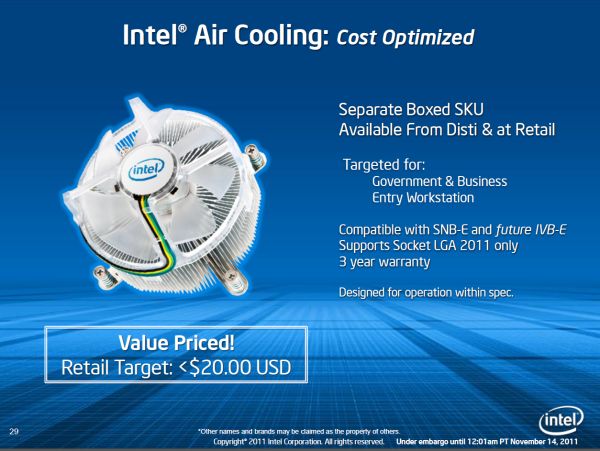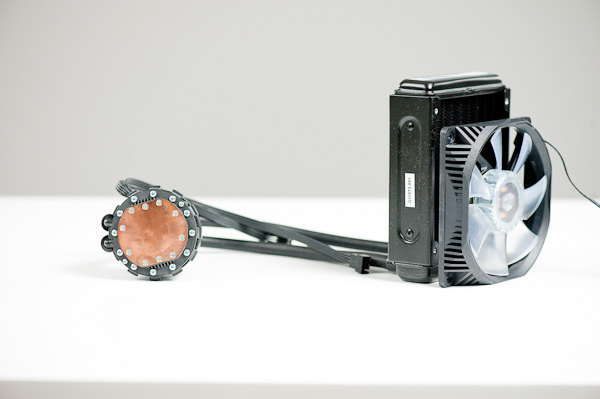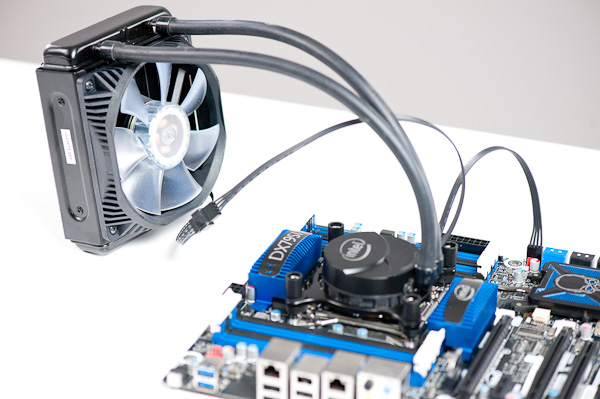Intel Core i7 3960X (Sandy Bridge E) Review: Keeping the High End Alive
by Anand Lal Shimpi on November 14, 2011 3:01 AM EST- Posted in
- CPUs
- Intel
- Core i7
- Sandy Bridge
- Sandy Bridge E
Overclocking
Sandy Bridge brought the motherboard's clock generator onto the 6-series chipset die. In doing so, Intel also locked its operation to 100MHz. While there was a bit of wiggle room, when combined with a locked processor, Intel effectively killed overclocking with most lower end Sandy Bridge chips.
For its more expensive CPUs, Intel offered either partially or fully unlocked (K-series) CPUs. The bus clock was still fixed at 100MHz, but you could overclock your processor by increasing its clock multiplier just like you could in the early days of overclocking.
With Sandy Bridge E, overclocking changes a bit. The clock generator is still mostly impervious to significant bus clock changes, however you're now able to send a multiple of its frequency to the CPU if you so desire. The options available are 100MHz, 125MHz, 166MHz and 250MHz.
Once again, wiggle room at any of these frequencies is limited so don't think we've moved back to the days of bus overclocking. You do get a little more flexibility, particularly with partially unlocked CPUs, but otherwise SNB-E overclocking is hardly any different from its predecessor.
Note that even if you select any of these options, the rest of the system still operates within spec. The multiplied bus clock is only fed to the CPU.

With a bit of effort I had no problems hitting 4.6GHz on my Core i7 3960X review sample. I had to increase core voltage from 1.104V to 1.44V, but the system was stable. While I could get into Windows at 4.8GHz and run a few benchmarks, the system wasn't completely stable.
No Cooler Included
None of the retail or OEM SNB-E parts include an Intel cooler in the bundle, a significant departure from previous CPUs. Presumably the cost of bundling a beefy cooler with these parts would've driven prices higher than Intel would've liked (remember you are getting a much larger die for roughly the same price as the outgoing Core i7 990X). Intel can also rationalize its decision against including any sort of cooler in the retail box by looking at the fact that many enthusiasts at this level opt for aftermarket cooling regardless.
Intel hasn't completely left SNB-E cooling up to 3rd party vendors however. There are two official Intel coolers available for use with SNB-E. The first is a < $20 heatsink that looks a lot like Intel's current coolers but with a couple of modifications (clear fan/shroud, retention screws instead of pegs). Intel states that this cooler is designed for operation within spec, meaning it could possibly limit overclocking attempts.

If you want an Intel branded overclocking solution, there's the RTS2011LC:

This is a closed loop liquid cooling solution similar to what AMD introduced alongside its Bulldozer CPU and similar to what many 3rd party cooling companies already offer. Intel expects its liquid cooling solution to be priced somewhere in the $85 - $100 range.
These closed loop liquid coolers are great primarily for getting away from the tower-of-metal heatsinks that have grown in popularity over the past several years. The radiator is a too small to compete with more traditional water cooling systems, but it can be a good gateway drug for the risk averse.











163 Comments
View All Comments
MOBAJOBG - Monday, November 14, 2011 - link
Thanks for performing the analysis and share those information with us.tenks - Monday, November 14, 2011 - link
Am I the only one disappointed with this review?nad, you usually give some amazing insight beyond the simple #s..In this case talking about whats coming up, if this is worth it compared to upcoming stuff in the pipe, or if the rumors about a respin with fixed features, or an allusion to IVy..etc etc etc..?
You've done it in the past. Are you just not allowed to touch on any of this per Intel?
It was a very vanilla review and I dont mean any disrespect, but thats not why I come here for.
Anand Lal Shimpi - Monday, November 14, 2011 - link
I appreciate the criticism. There are a bunch of things I wanted to do that I simply ran out of time for. I added another couple of paragraphs at the end of the conclusion, hopefully directly addressing your concern.To answer you here though: we may see a new chipset offering next year, but IVB-E will probably be at least a year out from now (perhaps even longer). If you need the core count, you will probably be fine on SNB-E while the rest of the world moves to quad-core IVB in the middle of next year.
Take care,
Anand
tenks - Monday, November 14, 2011 - link
Thanks for the response and updating the review..really cool of you. I didn't mean to come off not appreciative, because I am. Just a long time reader who loves the extra insight, reading between the lines and the dot connecting that you do so well...But the more I think about it, maybe it's just the platform itself that I'm disappointed with? Maybe there is no insight really to be had..There is no real "juice" or cool new info we didn't already know about. I guess with all the silence on the platform, even at IDF, I was hoping for that "And one more thing.." feature in SB-E that we didn't know about..Also, forgive me but I have to try..I know you know something..When well the new stepping and 8-core DESKTOP (EE) skus hit?
THizzle7XU - Monday, November 14, 2011 - link
Will there be a video review for this given the time? Your video reviews have been awesome and I really enjoy the conversation type of setting you present. Don't let anyone complain that they are too long :)Also, I was looking forward to this release, but in the last week I've decided to hold off for a while and see what happens with Ivy Bridge. My alternative upgrade ended up being a 512 GB Crucial M4 for my SATA 3 Sandy Bridge laptop and basically had a trickle down effect with moving my Intel 320 SSD to my Core 2 Quad desktop, desktop Intel G2 SSD to PS3, etc. I felt that was a better way to spend $700-$800 at this point for an upgrade that benefited all my devices instead of just my desktop. With the 22 nm process, it there any chance that the mainstream Ivy Bridge will see a 6-core chip? I thought I read some speculation on that...
yankeeDDL - Monday, November 14, 2011 - link
Call me cynical, but reading this review I couldn't help but thinking about AMD Bulldozer's fail.Would we have the 3960X priced $999, if the FX8150 had been able to deliver decent performance (meaning, an 8-core chip beating the i7 2600 by " a little", at $250)?
And the X79 looks just sloppy.
I'm afraid we're starting to see the effect of poor execution by AMD ...
velis - Monday, November 14, 2011 - link
Yep, agree 100%.The chipset released is - as Anand said - a rebrand of existing one. There is absolutely no reason at all to not include SATA 3 and USB 3 all across except if all budget for development was cut.
And the CPU is actually a step back from existing Sandy bridge offerings. No, that was an understatement - it's just a binned existing offering.
Next I'm expecting Ivy delay into late next year at best unless AMD gets its act together.
JlHADJOE - Monday, November 14, 2011 - link
Yes of course it will still be priced at $999.Maybe the 2500k and 2600k will drop in price a bit if Bulldozer had been more competitive, but Intel's Extreme Edition chips have always been pegged at $999.
Lest you forget, it was actually AMD's heydey that drove CPU prices up to the insane levels we are seeing today. Prior to Athlon's dominance, Intel's highest end chip during the Pentium II days, the PII-450 cost around $600.
AMD went on to dominate the chip space after they stuck with their excellent Athlon line, and Intel floundered with the Presshot. Intel was being dominated badly but managed to compete on price. It was AMD who first announced the $1100+ Athlon FX, forcing Intel to re-socket the Gallatin Xeon and sell it as the Pentium 4 Extreme Edition, just undercutting the Athlon FX's price by selling it at $999.
If you look at Intel's track record while they have the performance lead, they have actually been very reasonable with pricing. Recall the $200 Celeron 300A, for instance, which was pretty good at stock, and would overclock into a PII-450 destroyer. Just recently they introduced the brilliant Sandy Bridge, again at about $200-$250, despite the fact that the 2600k destroys their $999 980/990x in gaming.
It was when AMD had the performance lead that the $1000 CPU segment was established,one that has, for better or worse, persisted to this day (despite intel being currently the sole occupant of that segment space).
yankeeDDL - Monday, November 14, 2011 - link
Respectfully, I disagree.First of all, let me be clear: I am not rooting for AMD dominance: I am rooting for "competition" dominance. AMD jacked prices higher when teh Athlon was ridiculizing the P4, and would do so again -I'm sure- if it had the chance.
But it should be recognized that Intel is doing it now. It has "the power" to do so, but that doesn't make it any better for consumers.
Who "started" with the $1000-segment, frankly, is irrelevant: clearly Intel is enjoying it now, so let's focus on that, shall we?
And yes, Intel's top-of the line has always been $999 for a while, however, it is pretty clear that the 3960X is only marginally better than the much more reasonably priced 3930. I don't recall such huge drop in performance/price ratio ever before (I don't have data, but it strikes me as a particularly bad ROI for the 3960).
This said, the X79 is no excuse: re-branding is despicable, no matter who does it.
Also, I think that if the FX8150 was half teh CPU it was supposed to be, instead of the half-ass that it is, Intel would/should have come out with a better improvement over the existing offer, than the 3960 is.
They have delayed SB-E already by a bit, clearly, indicating that not always worked as they planned. If they had to provide an answer to AMD's "compelling" solution, I am sure they would have cranked up SB-E to be a more evident step forward over SB. But given Bulldozer's lack of performance, why bother? They could come out with SB-E "as-is" and not worry about the performance crown, no worry about the ROI, and no worry about cutting features.
just4U - Monday, November 14, 2011 - link
In my opinion, looking at these results Amd's FX8150 isn't so much of a fail after all. Sure it doesn't compare to this beast but they both seem to shine in multi threaded apps and don't seem to be geared up for desktop users. I was expecting to be blown away with the numbers here.... I am not.